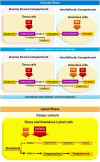Human steroidogenesis: implications for controlled ovarian stimulation with exogenous gonadotropins
- PMID: 25543693
- PMCID: PMC4396073
- DOI: 10.1186/1477-7827-12-128
Human steroidogenesis: implications for controlled ovarian stimulation with exogenous gonadotropins
Abstract
In the menstrual cycle, the mid-cycle surge of gonadotropins (both luteinising hormone [LH] and follicle-stimulating hormone [FSH]) signals the initiation of the periovulatory interval, during which the follicle augments progesterone production and begins to luteinise, ultimately leading to the rupture of the follicle wall and the release of an oocyte. The administration of gonadotropins in controlled ovarian stimulation (COS) leads to supraphysiological steroid concentrations of a very different profile compared with those seen during natural cycles. It has been suggested that these high steroid concentrations cause alterations in endometrial development, affecting oocyte viability in assisted reproductive technology. Furthermore, it has been proposed that elevated progesterone levels have a negative effect on the reproductive outcome of COS. This may arise from an asynchrony between embryo stage and endometrium status at the window of implantation. The regulation of progesterone production by the developing follicles during COS is a complicated interplay of hormonal systems involving the theca and granulosa cells, and the effect of the actions of both LH and FSH. The present paper reviews current knowledge of the regulation of progesterone in the human ovary during the follicular phase and highlights areas where knowledge remains limited. In this review, we provide in-depth information outlining the regulation and function of gonadotropins in the complicated area of steroidogenesis. Based on current evidence, it is not clear whether the high levels of progesterone produced during COS have detrimental effects on fertility.
Figures






References
-
- Horcajadas JA, Mínguez P, Dopazo J, Esteban FJ, Domínguez F, Giudice LC, Pellicer A, Simón C. Controlled ovarian stimulation induces a functional genomic delay of the endometrium with potential clinical implications. J Clin Endocrinol Metab. 2008;93:4500–4510. doi: 10.1210/jc.2008-0588. - DOI - PubMed
-
- Sullivan MW, Stewart-Akers A, Krasnow JS, Berga SL, Zeleznik AJ. Ovarian responses in women to recombinant follicle-stimulating hormone and luteinizing hormone (LH): a role for LH in the final stages of follicular maturation. J Clin Endocrinol Metab. 1999;84:228–232. - PubMed
-
- Jeppesen JV, Kristensen SG, Nielsen ME, Humaidan P, Dal Canto M, Fadini R, Schmidt KT, Ernst E, Yding Andersen C. LH-receptor gene expression in human granulosa and cumulus cells from antral and preovulatory follicles. J Clin Endocrinol Metab. 2012;97:E1524–E1531. doi: 10.1210/jc.2012-1427. - DOI - PMC - PubMed
Publication types
MeSH terms
Substances
LinkOut - more resources
Full Text Sources
Other Literature Sources
Medical

